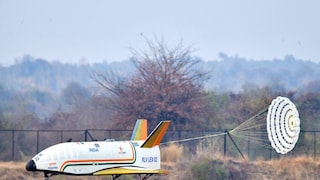Curated By: Asmita Ravi Shankar
News18.com
Last Updated: March 22, 2024, 10:46 IST
Challakere, India
Pushpak during its landing on the runway at ATR in Karnataka's Challakere. (Image: X/@isro)
The Indian Space Research Organisation’s RLV (reusable launch vehicle) — ‘Pushpak’ — successfully landed on the runway of the Aeronautical Test Range in Karnataka’s Challakere.
The winged vehicle was lifted an Indian Air Force helicopter, Chinook, and released from an altitude of 4.5 km. Following this, Pushpak “autonomously approached the runway along with cross-range corrections”, ISRO said in a statement.
RLV-LEX-02:The approach and the landing. pic.twitter.com/hI9k86KiBv— ISRO (@isro) March 22, 2024
The successful landing of the Pushpak marked a major milestone for the space agency in the area of RLV technology. The second of the series, RLV LEX-02 landing experiment was conducted at 7:10 am on Friday.
The Indian space agency carried out these successful missions previously in 2016 and April, 2023.
In its post on X, it said, “ISRO nails it again! Pushpak (RLV-TD), the winged vehicle, landed autonomously with precision on the runway after being released from an off-nominal position.”
RLV-LEX-02 Experiment:ISRO nails it again!Pushpak (RLV-TD), the winged vehicle, landed autonomously with precision on the runway after being released from an off-nominal position.
@IAF_MCC pic.twitter.com/IHNoSOUdRx
— ISRO (@isro) March 22, 2024
“With this second mission, ISRO has re-validated the indigenously developed technologies in the areas of navigation, control system, landing gear and deceleration systems essential for performing a high-speed autonomous landing of a space-returning vehicle,” the space agency said in its statement.
Earlier, ISRO chief S Somanath had said, “The Pushpak launch vehicle is India’s bold attempt to make access to space most affordable”.
“It is India’s futuristic RLV, where the most expensive part, the upper stage, which houses all the expensive electronics, is made reusable by bringing it back safely on Earth,” Somanath was quoted as saying by NDTV.
He said that the RLV can later perform “refuelling of in-orbit satellites or retrieving satellites from orbit for refurbishment”. The ISRO chief said that Pushpak is also a step towards India’s aim of “minimising space debris”.
According to Somanath, the rocket’s name comes from the ‘Pushpak Viman’ of the Ramayana, which is known as the vehicle of Kuber, lord of Wealth.
Union Minister Nitin Gadkari took to X to congratulate the space agency for “yet another remarkable achievement”.
“A proud moment for the nation! With the successful autonomous landing of #Pushpak (RLV-TD), India reaffirms its commitment to pioneering space exploration under PM Shri @narendramodi Ji’s leadership,” he wrote.
“This incredible feat showcases the unwavering dedication and ingenuity of ISRO scientists, pushing the boundaries of space access and affordability,” the Union Minister added.
Congratulations to @isro for yet another remarkable achievement! A proud moment for the nation! With the successful autonomous landing of #Pushpak (RLV-TD), India reaffirms its commitment to pioneering space exploration under PM Shri @narendramodi Ji’s leadership.
This…
— Nitin Gadkari (मोदी का परिवार) (@nitin_gadkari) March 22, 2024
ISRO’s statement noted that the “winged body and all flight systems used in RLV-LEX-01 were reused in the RLV-LEX-02 mission after due clearances”.
The mission was accomplished by Vikram Sarabhai Space Centre (VSSC) along with the Liquid Propulsion System Centre (LPSC) and the ISRO Inertial Systems Unit (IISU), the statement said, adding that “Collaboration from various agencies including IAF, ADE, ADRDE and CEMILAC contributed to the success of this mission”.
Following the successful landing of Pushpak, VSSC director Dr S Unnikrishnan Nair said that through its repeated success, “ISRO could master the terminal phase manouvering, landing and energy management in a fully autonomous mode, which is critical towards future orbital re-entry missions.”
The RLV mission costs an estimated Rs 100 crore, Somanath had told in his briefing to Prime Minister Narendra Modi last month.
